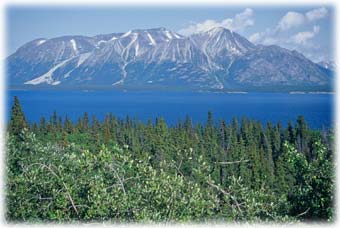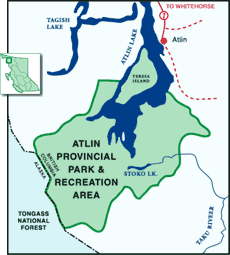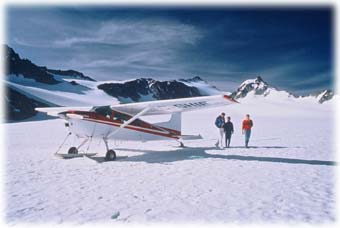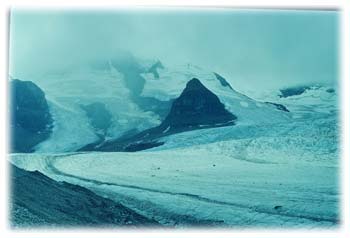|
|
|
|
|
|
|
 Atlin Provincial Park, in the far northwest of British Columbia, contains a variety of features unique to the province. The expansive Atlin Lake, at 775 km2 (300 mi2), is the largest natural body of freshwater in BC. The remote and wild park has several other superb smaller lakes too, resting at the base of the enormous surrounding icefields. Just two of these, Llewellyn Glacier (71,140 ha/175794 acres) and Willison Glacier (10165 ha/25118 acres), together cover almost one third of the park. The large Juneau Icefield crosses the Canadian/US border, extending into Alaska. The vast waters and dramatic mountains of 301,140 ha (744,147 acre) Atlin Park are exceptional destinations for outdoor enthusiasts. Atlin Provincial Park, in the far northwest of British Columbia, contains a variety of features unique to the province. The expansive Atlin Lake, at 775 km2 (300 mi2), is the largest natural body of freshwater in BC. The remote and wild park has several other superb smaller lakes too, resting at the base of the enormous surrounding icefields. Just two of these, Llewellyn Glacier (71,140 ha/175794 acres) and Willison Glacier (10165 ha/25118 acres), together cover almost one third of the park. The large Juneau Icefield crosses the Canadian/US border, extending into Alaska. The vast waters and dramatic mountains of 301,140 ha (744,147 acre) Atlin Park are exceptional destinations for outdoor enthusiasts.
|

Atlin Provincial Park is very remote. There is no access to the park by vehicle; entry is by boat or plane only, which may be chartered at the tiny town of Atlin. The community of Atlin is reached by travelling south along Highway 7 from the Yukon Territory. Highway 7 branches off of the main Alaska Highway at Jakes Corner, 60 km (37 mi) south east of Whitehorse.

Click on the map to view an enlargement
|
|
"The vast waters and dramatic mountains of Atlin Park are exceptional destinations for outdoor enthusiasts."

|

 Since the park is so remote and wild, the recreational activities available are mostly suitable for those who are experienced in self-sufficient backcountry techniques. There are no staff, facilities, or supplies available within the park. For those who do have the skills and experience, Atlin Provincial Park is an exhilarating area to explore. There are ample opportunities for hiking, camping, and mountaineering, as well as the simple but rare chance to experience true solitude and wildness. There are no developed camping areas, and those who are staying in the park are asked to remember to leave no trace. Trails within the park are not marked or maintained, so those wishing to hike must be skilled at map reading and route finding. Since the park is so remote and wild, the recreational activities available are mostly suitable for those who are experienced in self-sufficient backcountry techniques. There are no staff, facilities, or supplies available within the park. For those who do have the skills and experience, Atlin Provincial Park is an exhilarating area to explore. There are ample opportunities for hiking, camping, and mountaineering, as well as the simple but rare chance to experience true solitude and wildness. There are no developed camping areas, and those who are staying in the park are asked to remember to leave no trace. Trails within the park are not marked or maintained, so those wishing to hike must be skilled at map reading and route finding.
Kayaking on Atlin Lake is becoming increasingly popular, and it is now possible to do so privately trip or by contacting a commercial operator in the area. Other recreational opportunities in Atlin Park include fishing and horseback riding. Please visit Atlin Provincial Park site for more information.
The waters of Atlin Lake are known to be home to lake trout, Arctic grayling, Dolly Varden and two species of Whitefish. Anglers are reminded that they must have a valid fishing licence. Horseback riders must obtain a letter from Park authorites before bringing horses to the park.
|
|
"There are ample opportunities for hiking, camping, and mountaineering available, as well as the simple but rare chance to experience true solitude and wildness."

|

This northern park contains three of BC's 14 biogeoclimatic zones, the Boreal White and Black Spruce, the Spruce-Willow-Birch, and the Alpine Tundra. The park is also home to a wealth of wildlife species. In the park's lower areas both grizzly and black bears and are common, as are moose. At higher altitudes prevalent species include caribou, mountain goat and Stone sheep. Atlin Lake itself is excellent habitat for a variety of fish species including lake trout, Arctic grayling, Dolly Varden and two species of Whitefish.
"Atlin Lake itself is excellent habitat for a variety of fish species..."

|

The Tlingit were the earliest people to make extensive use of this area, leaving nearly 40 archaeological sites as evidence of their presence.
 Atlin Park was among a suite of parks created in 1973 by the NDP government, in an attempt to make up for the dismantling of Hamber Park. The former Social Credit government had diminished the park system by 740,000 hectares (1,828,614 acres) when they took apart Hamber Provincial Park in order to allow for damming of the Columbia River. Atlin Park, along with other parks (such as Cape Scott and Carp Lake) was created as a way to make up for this loss. Also BC Parks recognized the high preservation values of Atlin as an important addition to the parks system. Atlin Park was among a suite of parks created in 1973 by the NDP government, in an attempt to make up for the dismantling of Hamber Park. The former Social Credit government had diminished the park system by 740,000 hectares (1,828,614 acres) when they took apart Hamber Provincial Park in order to allow for damming of the Columbia River. Atlin Park, along with other parks (such as Cape Scott and Carp Lake) was created as a way to make up for this loss. Also BC Parks recognized the high preservation values of Atlin as an important addition to the parks system.
Prior to its protection, the area was threatened by a proposal by BC Hydro to direct the waters from Atlin Lake through a tunnel to the Taku River. The minister responsible for Atlin's protection, Bob Williams, did not want to see the unique landscape lost, so the government made the unusual decision to include the waters of Atlin Lake within the boundaries of the park. One of their intentions was to diminish the chance that the lake could become part of future hydroelectric projects.
An interesting characteristic of the park, its extensive glacial fields, has led to the Juneau Icefields being a focus for academic and scientific study. The glaciers of the park have proven to be a perfect outdoor laboratory, and the resulting support of the scientific community has served to further increase its conservation value.
"Atlin Lake itself is excellent habitat for a variety of fish species..."
|
|
Return to the Cassiar Region
Become Involved!

|
|

